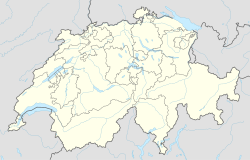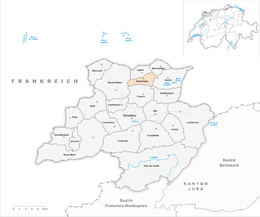Damphreux
| Damphreux | ||
|---|---|---|
|
||
| Coordinates: 47°29′N 07°06′E / 47.483°N 7.100°ECoordinates: 47°29′N 07°06′E / 47.483°N 7.100°E | ||
| Country | Switzerland | |
| Canton | Jura | |
| District | Porrentruy | |
| Government | ||
| • Mayor | Maire | |
| Area | ||
| • Total | 5.66 km2 (2.19 sq mi) | |
| Elevation | 420 m (1,380 ft) | |
| Population (Dec 2015) | ||
| • Total | 181 | |
| • Density | 32/km2 (83/sq mi) | |
| Postal code | 2933 | |
| SFOS number | 6787 | |
| Surrounded by | Lugnez, Beurnevésin, Bonfol, Vendlincourt, Coeuve, Courtemaîche, Montignez | |
| Website |
website missing SFSO statistics |
|
Damphreux is a municipality in the district of Porrentruy in the canton of Jura in Switzerland.
Damphreux is first mentioned in 1161 as Damfriol.
Damphreux has an area of 5.66 km2 (2.19 sq mi). Of this area, 3.53 km2 (1.36 sq mi) or 62.4% is used for agricultural purposes, while 1.78 km2 (0.69 sq mi) or 31.4% is forested. Of the rest of the land, 0.29 km2 (0.11 sq mi) or 5.1% is settled (buildings or roads), 0.03 km2 (7.4 acres) or 0.5% is either rivers or lakes and 0.03 km2 (7.4 acres) or 0.5% is unproductive land.
Of the built up area, housing and buildings made up 2.3% and transportation infrastructure made up 2.3%. Out of the forested land, all of the forested land area is covered with heavy forests. Of the agricultural land, 38.7% is used for growing crops and 23.3% is pastures. Of the water in the municipality, 0.4% is in lakes and 0.2% is in rivers and streams.
The municipality is located in the Porrentruy district.
The blazon of the municipal coat of arms is Argent, a Squirrel Gules holding an Acorn Vert sitting on a Mount of the last.
Damphreux has a population (as of December 2015[update]) of 181. As of 2008[update], 7.2% of the population are resident foreign nationals. Over the last 10 years (2000–2010) the population has changed at a rate of -1.7%. Migration accounted for -4.7%, while births and deaths accounted for 2.3%.
Most of the population (as of 2000[update]) speaks French (144 or 86.7%) as their first language, German is the second most common (19 or 11.4%) and Italian is the third (1 or 0.6%).
...
Wikipedia




